Amidst the advancing technological inventions in the defence field, the Israel-Hamas war stands because of the keen interests of global powers like the US and China.
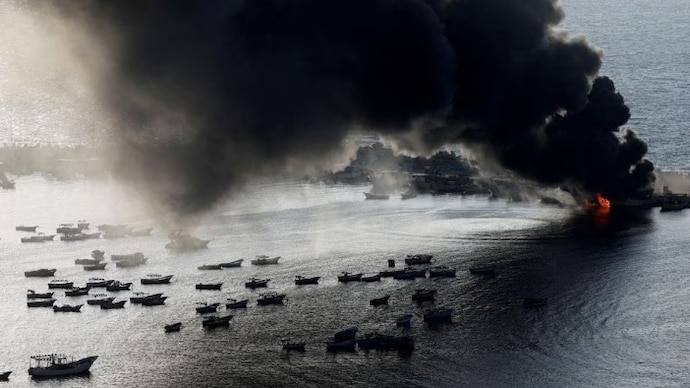
Smoke rises after Israeli strikes on the seaport of Gaza City, in Gaza, October 10, 2023. (Photo: Reuters)
Dipti Yadav
New Delhi,
UPDATED: Nov 4, 2023
Edited By: Aishwarya Dakhore
As the world is witnessing two post-modern era wars in the 21st century, the traditional norms of wars have majorly evolved. These are the times of constantly advancing technological inventions in the defence field. A military vehicle run by artificial intelligence or an underwater sea drone do not come off as a surprise anymore.
Moreover, the ongoing Israel-Hamas war is set apart because of the active involvement of global superpowers despite it being a regional conflict. The US has time and again shown unabashed support for Israel not just verbally, but also de facto by sending six of its warships to assist Israel.
China, meanwhile, has sent a few of its naval warships to analyse the seriousness of the situation. The world is currently split into two as nations like Russia and China show undeterred support for Palestine, while the western lot supports Israel.
The seas around Israel and Palestine remain the most vulnerable to unexpected attacks. The iron dome interception system along the Israel-Gaza border wall acts as a good deterrence against Hamas for Israel. It is not easy to bypass such advanced security apparatus.
Tunnels are undoubtedly a major factor contributing to Hamas' repeated incursions, though it's high time for Israel to focus on what's broiling at the sea.
To address these challenges, Israel has its Israeli Naval Force, that keeps vigil for minute changes at the tides. As for Hamas, they have their very own Nukhba forces specified for such purposes.
On Telegram, there's a noticeable bustling on the Israel Defence Forces' (IDF) channel. Dozens of footage have been shared by Israel to boast their counter-operation against Hamas.
As the seas provide a leeway for Hamas to enter Israel, the most obvious routes become either the Ashdod port or Zikim beach, both of which are at a nearer distance from the Gaza strip. However, Israel would not expect any incursion from Eilat port as it remains at the far end of their territory, which also means a considerable distance from Palestine.
Analysing these crucial strike videos leaves us with some visible clues about how the entire process is being thoroughly planned. One may notice the intensive use of tugboats on both sides via several IDF videos.
Looking at five major Israeli ports, at least one tug has been kept to be used during surprise attacks by Hamas. Regular AIS spoofing of Israeli vessels involved in the counter-ops is another thing which has remained widely conspicuous.
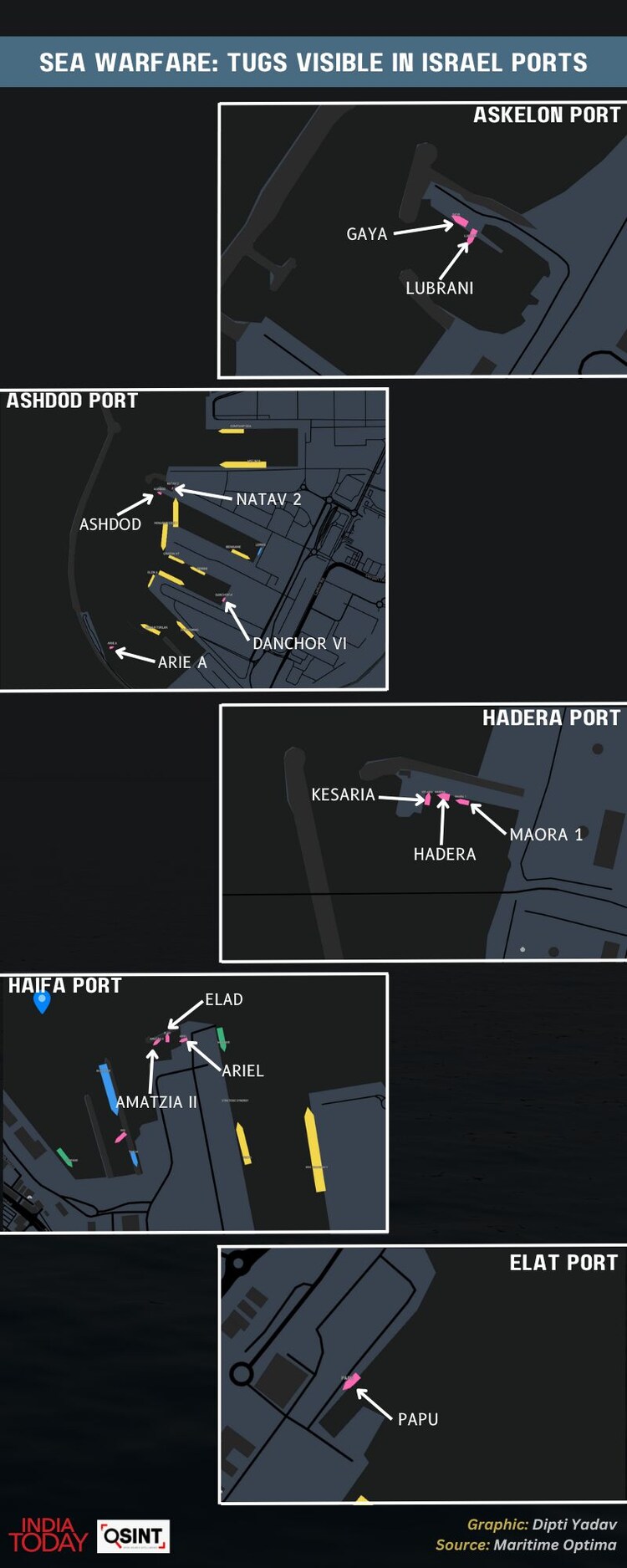
In one of the shared footage, a vessel called 'Nuray Senkaya' can be seen docked near a port -- the Israeli port of Ashdod where Israel and Hamas vessels were playing cat and mouse. The description of the video shared on Telegram says it is shot only a few days ago.
A quick glance at the historical AIS data of the cargo ship in the background (Nuray Senkaya) reveals the stay duration of the vessel at the Ashdod port -- from October 3 to October 9. Keeping in view the initiation date of the conflict (October 7), it is likely that the operation was conducted in that three-day gap.
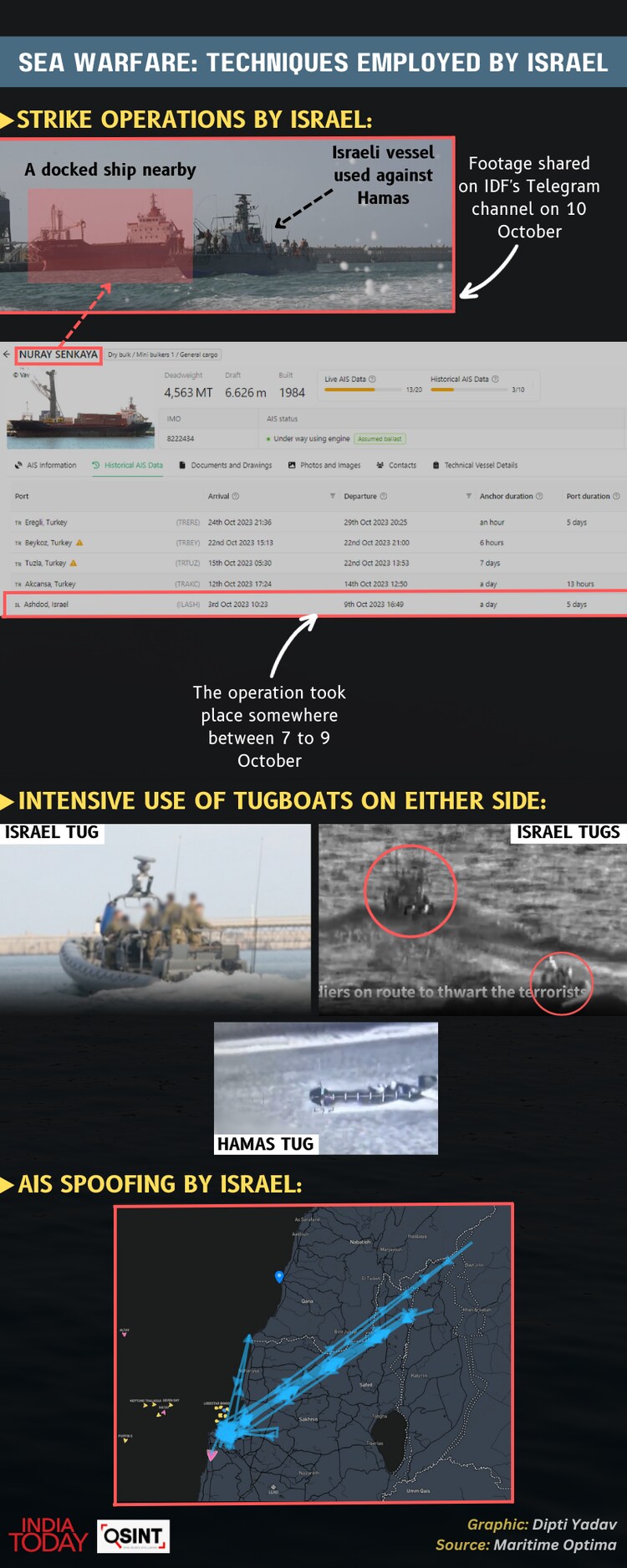
Countries like France, Qatar, and India have also sent humanitarian aid for Israeli and Palestinian citizens to help them in distressing times. A Sri Lankan navy vessel was also seen docked at Ashdod port for unknown reasons on October 31.
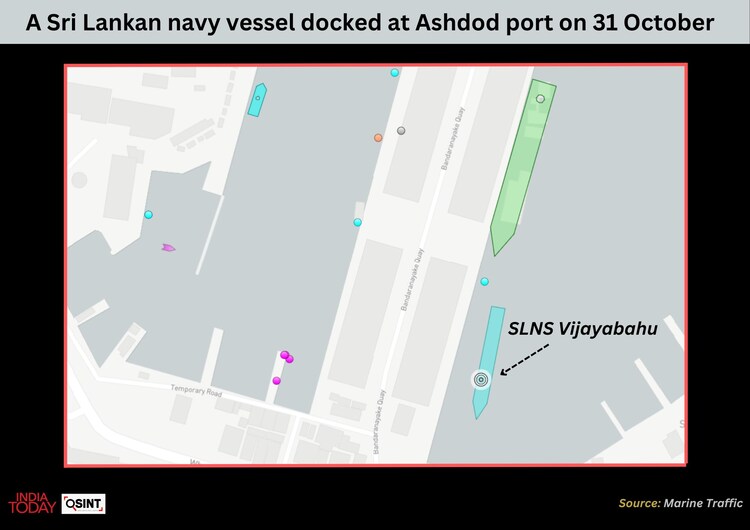
Soon after a brief naval exercise with Oman, China’s 44th naval escort task force arrived in Kuwait for a five-day goodwill visit on October 18 as per a statement from the Chinese Ministry of Defence. These endeavours by China in the Middle East are being construed as a pretext to keep an eye on how the war unfolds.
Simultaneously, the United States is also maintaining a constant presence in the eastern Mediterranean using its warships and their associated battle groups.
Now that this fresh war is on the rise in the Middle-east, it would be rather wise for both parties (Israel and Palestine) to take lessons from the still ongoing Russia-Ukraine conflict where the use of advanced sea equipment has been witnessed every now and then, ranging from a kamikaze motor boat to something like an underwater sea drone.
However, in case of underwater sea drones, its usage by Hamas against their adversary (Israel) has just recently been discovered by naval warfare analyst HI Sutton.
How is Israel handling possible aerial assault?
Aerial assault is another defence realm that comes under the purview of a full-blown war. Regular instances of ADS-B spoofing have been witnessed on Israel's part by OSINT experts in order to keep its planes' locations undisclosed to adversaries that may track their movements. Often, flight paths that make no sense in actuality are highly likely to employ a spoofed location to sustain the undercover operations.
On October 31, an aircraft with an empty callsign is likely to be monitoring a specific area under the Gaza strip through the skies. Also, several Israeli military planes were seen operating over certain areas of Israel on the same day, apparently for defence movements.
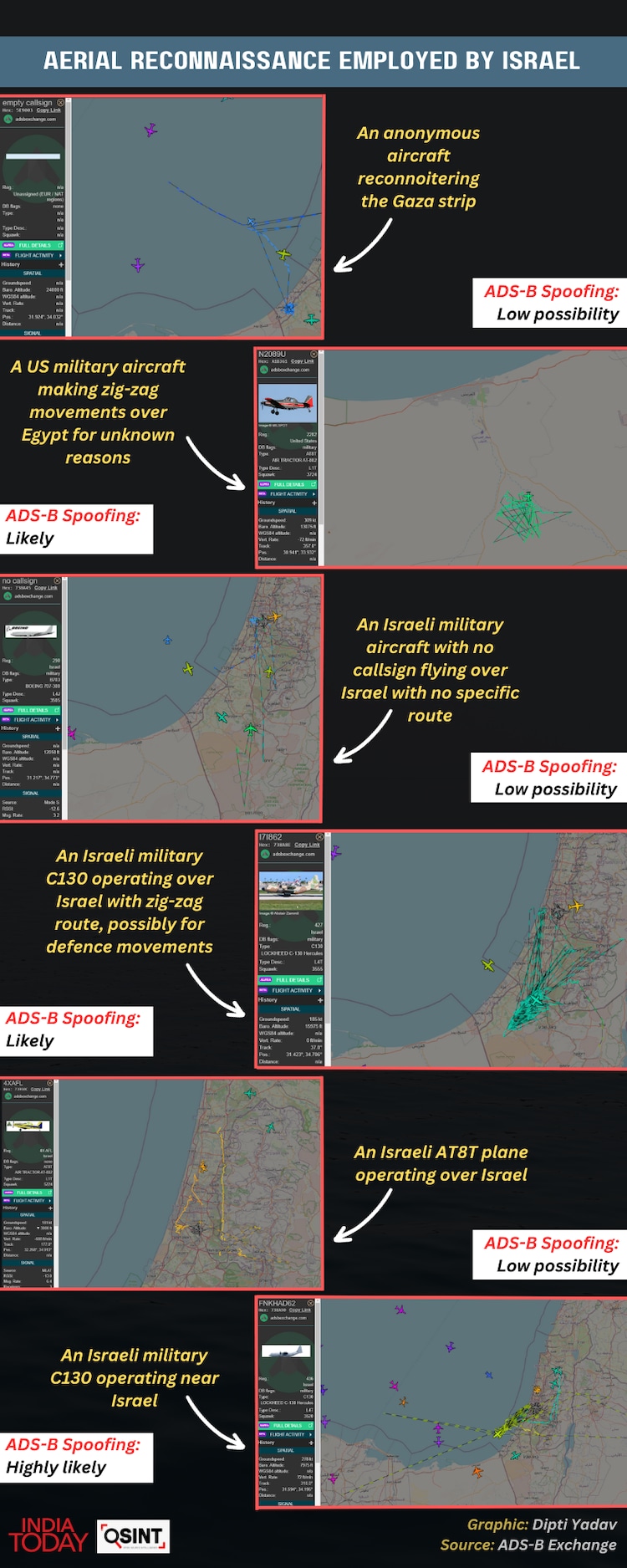
However, there's a questionable trend in the Israeli region of a single French C130 aircraft, with registration '102', that keeps making repeated manoeuvres there occasionally.
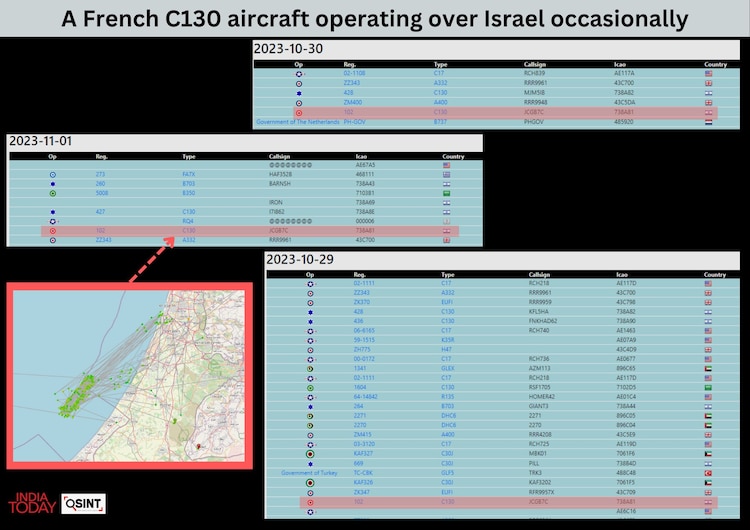
A Submarine Veteran decodes the situation
We reached out to Ex-Commodore Anil Jai Singh of the Indian Navy, a submarine expert who is specialised in undersea warfare, to get him to share his insight on how the naval tension between Israel and Hamas could play out in the ensuing days of the war.
On the possibility of Hamas posing an unanticipated risk on the sea front, he commented “I think it's very important firstly to understand the group, their motivation, how they would go about it, and for that we require very good actionable intelligence.”
Stressing on the types of intelligence often used during a conflict, he mentioned HUMINT (Human Intelligence) which is the primary means of monitoring terrorist groups, SIGINT (Signal Intelligence) which is used to intercept communications such as telephone conversations, and ELINT (Electronic Intelligence) which, as per him, basic terrorist groups might not be quite well-versed with, given the lack of sophisticated electronics.
For detecting dubious vessels, he suggested looking out for ships with an in-built AIS (Automatic Identification System). He further added that in some cases, “if there’s a boat of a particular length, and it has gone dark, and it has not switched on its AIS beacon, then that is a sure sure red flag.”
As the Israeli port of Eilat falls quite opposite to the Gaza strip, the possibility of it being considered the “most secure” remains high.
Our team asked the Navy veteran to guide us on the likelihood of Israel being taken by surprise by Hamas on that front, to which he said “As far as the present situation is concerned, I think Hamas has lost the element of surprise, be it from the sea, or from the land, they are under pressure. Israel has launched a retaliatory attack of amazing proportion, and in fact totally disproportionate to the kind of threat, with the obvious intention of eradicating Hamas once and for all."
"So, I don’t think Hamas will be able to surprise Israel from the sea. It may be able to get some traction. But Israel's naval defences, and naval capability is too robust and too powerful for Hamas to be able to penetrate,” he added.
Regarding the extent of both adversaries employing advanced naval defence systems -- given that Hamas have been found to be using underwater sea drones -- he stressed that Hamas cannot match Israel’s capability in defence preparedness.
"Israel is a global leader in unmanned autonomous technologies, both below and above the water, and has lots of very formidable underwater capabilities in that domain. While yes, Hamas is operating, or is known to operate undersea drones, I am sure Israel is more than capable of countering these, and taking on anything that Hamas can throw at them underwater.”
Published By:
Aishwarya Dakhore
Published On:
Nov 4, 2023
Edited By: Aishwarya Dakhore
As the world is witnessing two post-modern era wars in the 21st century, the traditional norms of wars have majorly evolved. These are the times of constantly advancing technological inventions in the defence field. A military vehicle run by artificial intelligence or an underwater sea drone do not come off as a surprise anymore.
Moreover, the ongoing Israel-Hamas war is set apart because of the active involvement of global superpowers despite it being a regional conflict. The US has time and again shown unabashed support for Israel not just verbally, but also de facto by sending six of its warships to assist Israel.
China, meanwhile, has sent a few of its naval warships to analyse the seriousness of the situation. The world is currently split into two as nations like Russia and China show undeterred support for Palestine, while the western lot supports Israel.
The seas around Israel and Palestine remain the most vulnerable to unexpected attacks. The iron dome interception system along the Israel-Gaza border wall acts as a good deterrence against Hamas for Israel. It is not easy to bypass such advanced security apparatus.
Tunnels are undoubtedly a major factor contributing to Hamas' repeated incursions, though it's high time for Israel to focus on what's broiling at the sea.
To address these challenges, Israel has its Israeli Naval Force, that keeps vigil for minute changes at the tides. As for Hamas, they have their very own Nukhba forces specified for such purposes.
On Telegram, there's a noticeable bustling on the Israel Defence Forces' (IDF) channel. Dozens of footage have been shared by Israel to boast their counter-operation against Hamas.
As the seas provide a leeway for Hamas to enter Israel, the most obvious routes become either the Ashdod port or Zikim beach, both of which are at a nearer distance from the Gaza strip. However, Israel would not expect any incursion from Eilat port as it remains at the far end of their territory, which also means a considerable distance from Palestine.
Analysing these crucial strike videos leaves us with some visible clues about how the entire process is being thoroughly planned. One may notice the intensive use of tugboats on both sides via several IDF videos.
Looking at five major Israeli ports, at least one tug has been kept to be used during surprise attacks by Hamas. Regular AIS spoofing of Israeli vessels involved in the counter-ops is another thing which has remained widely conspicuous.

In one of the shared footage, a vessel called 'Nuray Senkaya' can be seen docked near a port -- the Israeli port of Ashdod where Israel and Hamas vessels were playing cat and mouse. The description of the video shared on Telegram says it is shot only a few days ago.
A quick glance at the historical AIS data of the cargo ship in the background (Nuray Senkaya) reveals the stay duration of the vessel at the Ashdod port -- from October 3 to October 9. Keeping in view the initiation date of the conflict (October 7), it is likely that the operation was conducted in that three-day gap.

Countries like France, Qatar, and India have also sent humanitarian aid for Israeli and Palestinian citizens to help them in distressing times. A Sri Lankan navy vessel was also seen docked at Ashdod port for unknown reasons on October 31.

Soon after a brief naval exercise with Oman, China’s 44th naval escort task force arrived in Kuwait for a five-day goodwill visit on October 18 as per a statement from the Chinese Ministry of Defence. These endeavours by China in the Middle East are being construed as a pretext to keep an eye on how the war unfolds.
Simultaneously, the United States is also maintaining a constant presence in the eastern Mediterranean using its warships and their associated battle groups.
Now that this fresh war is on the rise in the Middle-east, it would be rather wise for both parties (Israel and Palestine) to take lessons from the still ongoing Russia-Ukraine conflict where the use of advanced sea equipment has been witnessed every now and then, ranging from a kamikaze motor boat to something like an underwater sea drone.
However, in case of underwater sea drones, its usage by Hamas against their adversary (Israel) has just recently been discovered by naval warfare analyst HI Sutton.
How is Israel handling possible aerial assault?
Aerial assault is another defence realm that comes under the purview of a full-blown war. Regular instances of ADS-B spoofing have been witnessed on Israel's part by OSINT experts in order to keep its planes' locations undisclosed to adversaries that may track their movements. Often, flight paths that make no sense in actuality are highly likely to employ a spoofed location to sustain the undercover operations.
On October 31, an aircraft with an empty callsign is likely to be monitoring a specific area under the Gaza strip through the skies. Also, several Israeli military planes were seen operating over certain areas of Israel on the same day, apparently for defence movements.

However, there's a questionable trend in the Israeli region of a single French C130 aircraft, with registration '102', that keeps making repeated manoeuvres there occasionally.

A Submarine Veteran decodes the situation
We reached out to Ex-Commodore Anil Jai Singh of the Indian Navy, a submarine expert who is specialised in undersea warfare, to get him to share his insight on how the naval tension between Israel and Hamas could play out in the ensuing days of the war.
On the possibility of Hamas posing an unanticipated risk on the sea front, he commented “I think it's very important firstly to understand the group, their motivation, how they would go about it, and for that we require very good actionable intelligence.”
Stressing on the types of intelligence often used during a conflict, he mentioned HUMINT (Human Intelligence) which is the primary means of monitoring terrorist groups, SIGINT (Signal Intelligence) which is used to intercept communications such as telephone conversations, and ELINT (Electronic Intelligence) which, as per him, basic terrorist groups might not be quite well-versed with, given the lack of sophisticated electronics.
For detecting dubious vessels, he suggested looking out for ships with an in-built AIS (Automatic Identification System). He further added that in some cases, “if there’s a boat of a particular length, and it has gone dark, and it has not switched on its AIS beacon, then that is a sure sure red flag.”
As the Israeli port of Eilat falls quite opposite to the Gaza strip, the possibility of it being considered the “most secure” remains high.
Our team asked the Navy veteran to guide us on the likelihood of Israel being taken by surprise by Hamas on that front, to which he said “As far as the present situation is concerned, I think Hamas has lost the element of surprise, be it from the sea, or from the land, they are under pressure. Israel has launched a retaliatory attack of amazing proportion, and in fact totally disproportionate to the kind of threat, with the obvious intention of eradicating Hamas once and for all."
"So, I don’t think Hamas will be able to surprise Israel from the sea. It may be able to get some traction. But Israel's naval defences, and naval capability is too robust and too powerful for Hamas to be able to penetrate,” he added.
Regarding the extent of both adversaries employing advanced naval defence systems -- given that Hamas have been found to be using underwater sea drones -- he stressed that Hamas cannot match Israel’s capability in defence preparedness.
"Israel is a global leader in unmanned autonomous technologies, both below and above the water, and has lots of very formidable underwater capabilities in that domain. While yes, Hamas is operating, or is known to operate undersea drones, I am sure Israel is more than capable of countering these, and taking on anything that Hamas can throw at them underwater.”
Published By:
Aishwarya Dakhore
Published On:
Nov 4, 2023
No comments:
Post a Comment